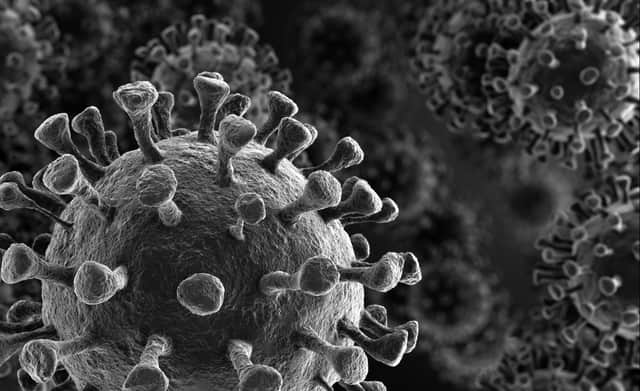These are your chances of dying from coronavirus


The World Health Organisation (WHO), as well as other global health agencies, has condemned the spread of misinformation via social media platforms, calling it an infodemic.
But viral outbreaks are scary, and with the world teetering on the verge of a global pandemic, what are the true facts about the mortality rate of the coronavirus strain known as Covid-19?
Advertisement
Hide AdAdvertisement
Hide AdResearchers have suggested that the death rate for this viral disease is anywhere between five and 40 in 1,000. But this is a wide data range, meaning an exact mortality rate - the rate at which cases of the disease lead to death - is difficult to pin down.
On Sunday, the UK government's health secretary, Matt Hancock, said that the "very best assessment" was that the mortality rate was "two per cent or likely lower". But this depends on a range of factors including sex, age, general health, and the condition of healthcare provision.
Different levels of severity
The main issue with coronavirus is its 14 day incubation period. An infected person can have the virus and spread the disease without showing any symptoms themselves. At this time of year, coughs and colds are common so very few people will go to the GP for such mild symptoms.
However, a worse case scenario would be everyone with a cough or a cold piling on extra strain to the NHS and other healthcare providers. It is a constant challenge to try and raise awareness of the disease without spreading unnecessary panic.
Advertisement
Hide AdAdvertisement
Hide AdResearchers from Imperial College have stated that differences in detecting the virus across the world are based on one countries ability to detect milder symptoms than another.
Counting the death rate
Scientists monitor the cases with mild symptoms from small groups - such as those trapped on the Diamond Princess ferry, or those returning on repatriated flights from China.
This allows them to analyse a data set to come up with a potential mortality rate. Different findings combined across the world can be pulled together to try and identify differences between groups - men, women, children, elderly and the sick.
This leads to growing picture of whom the disease affects and how, but as yet it is extremely difficult to determine a single death rate for the whole population.
Advertisement
Hide AdAdvertisement
Hide AdCurrent evidence points towards men being affected more than women, and there have been fewer deaths in cases under 30 years old, compared to the elderly. But a group of older men in China may have a significantly different mortality rate to one in the UK.
Is it more dangerous than the flu?
Misinformation causes more illness and the spread of it is unethical. The idea that coronavirus is better or worse than the common flu is yet unknown - and potentially not a fair comparison. People with mild flu symptoms don't tend to go to the doctor, but the flu does still kill people every year.
As the data evolves, scientists will be able to answer these questions in more depth. What is important now is that people wash their hands, capture sneezes and coughs, and practice a strict hygiene regime.
According to the WHO, this is the best way to stop a respiratory illness, such as Covid-19.
Coronavirus: the facts
What is coronavirus?
Advertisement
Hide AdAdvertisement
Hide AdCOVID-19 is a respiratory illness that can affect lungs and airways. It is caused by a virus called coronavirus.
What caused coronavirus?
The outbreak started in Wuhan in China in December 2019 and it is thought that the virus, like others of its kind, has come from animals.
How is it spread?
As this is such a new illness, experts still aren’t sure how it is spread. But.similar viruses are spread in cough droplets. Therefore covering your nose and mouth when sneezing and coughing, and disposing of used tissues straight away is advised. Viruses like coronavirus cannot live outside the body for very long.
What are the symptoms?
The NHS states that the symptoms are: a dry cough, high temperature and shortness of breath - but these symptoms do not necessarily mean you have the illness. Look out for flu-like symptoms, such as aches and pains, nasal congestion, runny nose and a sore throat. It’s important to remember that some people may become infected but won’t develop any symptoms or feel unwell.
What precautions can be taken?
Advertisement
Hide AdAdvertisement
Hide AdWashing your hands with soap and water thoroughly. The NHS also advises to cover your mouth and nose with a tissue or your sleeve (not your hands) when you cough or sneeze; put used tissues in the bin immediately and try to avoid close contact with people who are unwell. Also avoiding touching eyes, nose and mouth unless your hands are clean.
Should I avoid public places?
Most people who feel well can continue to go to work, school and public places and should only stay at home and self isolate if advised by a medical professional or the coronavirus service.
What should I do if I feel unwell?
Don’t go to your GP but instead call NHS 111 or look online at the coronavirus service that can tell you if you need medical help and what to do next.
When to call NHS 111
NHS 111 should be used if you feel unwell with coronavirus symptoms, have been in a country with a high risk of coronavirus in the last 14 days or if you have been in close contact with someone with the virus.
Sources: World Health Organisation and NHS